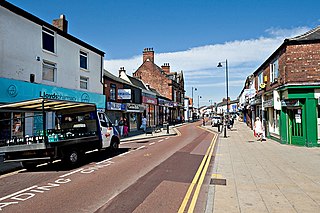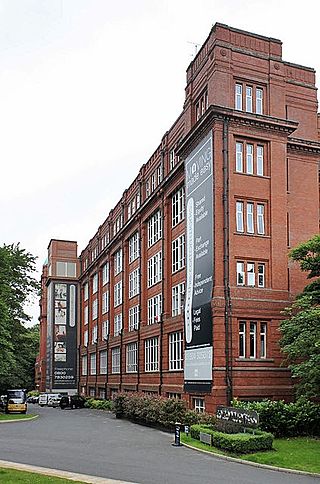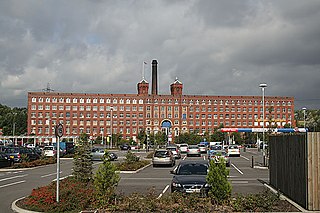
Mather Lane Mills was a complex of cotton mills built by the Bridgewater Canal in Bedford, Leigh in Lancashire, England. The No 2 mill and its former warehouse are grade II listed buildings.

Mather Lane Mills was a complex of cotton mills built by the Bridgewater Canal in Bedford, Leigh in Lancashire, England. The No 2 mill and its former warehouse are grade II listed buildings.
The Mather Lane Company was formed at a meeting in the Black Horse public house in Leigh. Thomas Smith, a self-educated man was voted to the chair and Richard Thomas Marsh became its managing director from its inception until 1920. The first mill's working capital was £60,000 when it became operational in 1878. A second mill opened in 1883 and the third in 1891. In the 1920s, the company was merged into Combined Egyptian Mills Ltd. [1]

The second Mather Lane Mill is a Grade II listed cotton spinning mill on the north bank of the Bridgewater Canal. It was built in 1882 to the designs of Bradshaw and Gass of Bolton and is notable for its severe classical elevations. It is an important early factory design by the architects and has features unusual for its date including a square plan, flat roof and its partly internal engine house. The mill has six storeys and a basement built in brick in English garden wall bond with panelled pilasters at the corners. Three-storey carding sheds on the south side are parallel to the canal and set obliquely to main mill. Its engine house is on the north side and its tower at the north-west corner is panelled with moulded string courses. The tower rises above parapet level where there are large lunettes below a blind arcade of round-headed arches, parapet and it has a pyramidal roof. [2]
The mill's six by ten bays contain iron-framed windows. The east and west elevations have large windows with continuous central iron box columns rising through the first to fourth floors. The north and south elevations have single-light windows. Inside the ceilings are supported by iron girders on Tuscan columns. [2]
Mill No 2, was redeveloped in the early 2020s by JP McGuire Developments in 98 one, two and three bedroom apartments called Loom Wharf. It forms a modern residential complex, utilising the former cotton stores in the basement as car parking, seven levels of luxury apartments and state of the art gym facilities. [3]
Mill No 3, also known as Brooklands Mill, was constructed on the opposite (south) side of the Bridgewater Canal.

The mill's former warehouse on the opposite side of Mather Lane is also grade II listed. It was built around 1882, probably also to designs by Bradshaw and Gass. It is a plain brick structure with three storeys overlooking the canal. It has hoists and taking-in bays on the front and canal elevations. [4]

The Bridgewater Canal connects Runcorn, Manchester and Leigh, in North West England. It was commissioned by Francis Egerton, 3rd Duke of Bridgewater, to transport coal from his mines in Worsley to Manchester. It was opened in 1761 from Worsley to Manchester, and later extended from Manchester to Runcorn, and then from Worsley to Leigh.

Castlefield is an inner-city conservation area in Manchester, North West England. The conservation area which bears its name is bounded by the River Irwell, Quay Street, Deansgate and Chester Road. It was the site of the Roman era fort of Mamucium or Mancunium which gave its name to Manchester. It was the terminus of the Bridgewater Canal, the world's first industrial canal, built in 1764; the oldest canal warehouse opened in 1779. The world's first passenger railway terminated here in 1830, at Liverpool Road railway station and the first railway warehouse opened here in 1831.

Leigh is a town in the Metropolitan Borough of Wigan, Greater Manchester, England, on low-lying land northwest of Chat Moss.

Boothstown is a suburban village in the City of Salford in Greater Manchester, England. Boothstown forms part of the Boothstown and Ellenbrook ward, which had a population at the 2011 Census of 9,599. The village is within the boundaries of the historic county of Lancashire, west of the City of Salford, bordered to the north by the East Lancashire Road A580 and to the south by the Bridgewater Canal. Historically, it was a hamlet partly in Worsley township in the parish of Eccles, and partly in Tyldesley in the parish of Leigh.

Atherton is a town in the Metropolitan Borough of Wigan in Greater Manchester, England and historically part of Lancashire. The town, including Hindsford, Howe Bridge and Hag Fold, is 5 miles (8.0 km) south of Bolton, 7 miles (11.3 km) east of Wigan, and 10 miles (16.1 km) northwest of Manchester. From the 17th century, for about 300 years, Atherton was known as Chowbent, which was frequently shortened to Bent, the town's old nickname. During the Industrial Revolution, the town was a key part of the Manchester Coalfield.

Astley is a village in the Metropolitan Borough of Wigan, Greater Manchester, England. Within the boundaries of the historic county of Lancashire, it is crossed by the Bridgewater Canal and the A580 East Lancashire Road. Continuous with Tyldesley, it is between Wigan and Manchester, both 8 miles (13 km) away. Astley Mosley Common ward had a population of 11,270 at the 2011 Census.

Bradshaw Gass & Hope is an English architectural practice founded in 1862 by Jonas James Bradshaw. It is Bolton's oldest architectural practice and has exhibited archive drawings in London and Manchester. The style "Bradshaw Gass & Hope" was adopted after Bradshaw's death to incorporate the names of the remaining partners, John Bradshaw Gass and Arthur John Hope. As of 2022, the firm continues to operate from offices in Bolton.

The architecture of Manchester demonstrates a rich variety of architectural styles. The city is a product of the Industrial Revolution and is known as the first modern, industrial city. Manchester is noted for its warehouses, railway viaducts, cotton mills and canals – remnants of its past when the city produced and traded goods. Manchester has minimal Georgian or medieval architecture to speak of and consequently has a vast array of 19th and early 20th-century architecture styles; examples include Palazzo, Neo-Gothic, Venetian Gothic, Edwardian baroque, Art Nouveau, Art Deco and the Neo-Classical.

Beehive Mill is a Grade II* listed former cotton mill in the district of Ancoats in Manchester, England. It is located on a site surrounded by Radium Street, Jersey Street, Bengal Street and Naval Street.

Bedford, a suburb of Leigh, Greater Manchester is one of three ancient townships, Bedford, Pennington and Westleigh, that merged in 1875 to form the town of Leigh. Historically, Bedford was in Lancashire.
Barnfield Mills was a complex of cotton mills that operated in Tyldesley, Greater Manchester, England from the middle of the 19th century.

Sacred Heart Church is a Grade II listed redundant Roman Catholic church on Tyldesley Road, Hindsford, Atherton in Greater Manchester, England. It has been designated by English Heritage as a Grade II listed building.
Havelock Mills in central Manchester were built between 1820 and 1840. It was probably the largest surviving silk mill in the north-west region in the 1970s and had a unique combination of silk and cotton mills on one site. It was a landmark on the Rochdale Canal, overlooking Tib Lock, one of the Rochdale Nine.

Leigh Spinners or Leigh Mill is a Grade II* listed former cotton mill in Leigh, Greater Manchester. After being disused for many years one of the mill buildings has been redeveloped into an arts and heritage centre.

Swan Lane Mills is a former cotton mill complex in Bolton, Greater Manchester, England. All three mills are Grade II* listed buildings. The mills were designed by Stott and Sons of Oldham. When completed, the double mill was the largest spinning mill in the world. It was granted Grade II* listed status on 26 April 1974. Number 3 Mill was separately listed as Grade II* on the same day.

Stockport Central Library is a Carnegie library in Stockport, Greater Manchester, England. It was built in 1913–15 to designs by Bradshaw, Gass and Hope in the Edwardian Baroque style and as of 2023 continues to serve as Stockport's largest library.

Astley Bridge Mill or Holden Mill is a former cotton mill in the district of Astley Bridge in Bolton, Greater Manchester, England, which has since been converted into an apartment building. Constructed in 1926 for Sir John Holden & Sons Ltd, it was the last cotton mill to be built in Bolton and is a Grade II listed building.
Leigh is a town in the Metropolitan Borough of Wigan, Greater Manchester, England. The town, together with its suburbs of Bedford, Westleigh and Pennington, contains 33 listed buildings that are recorded in the National Heritage List for England. Of these, four are listed at Grade II*, the middle of the three grades, and the others are at Grade II, the lowest grade.

Meadow Mill is a historic cotton mill in Stockport, Greater Manchester, England. It is located on the south bank of the River Tame opposite a Tesco Extra supermarket and the M60 motorway. The seven-storey building was built in c.1880 for the spinning of cotton and wool by T & J Leigh Ltd, designated as a Grade II listed building in 1975, and redeveloped into 200 apartments with a mixed-use ground floor in 2021.
Notes
Bibliography
Hall Lane and Mather Lane Cotton Spinning Mills, Leigh, 1929 from Britain from above